Which lead-free bullet performs best? Broadsword compares the new CCI Copper-22 with Hornady’s copper-clad Varmint Express HP
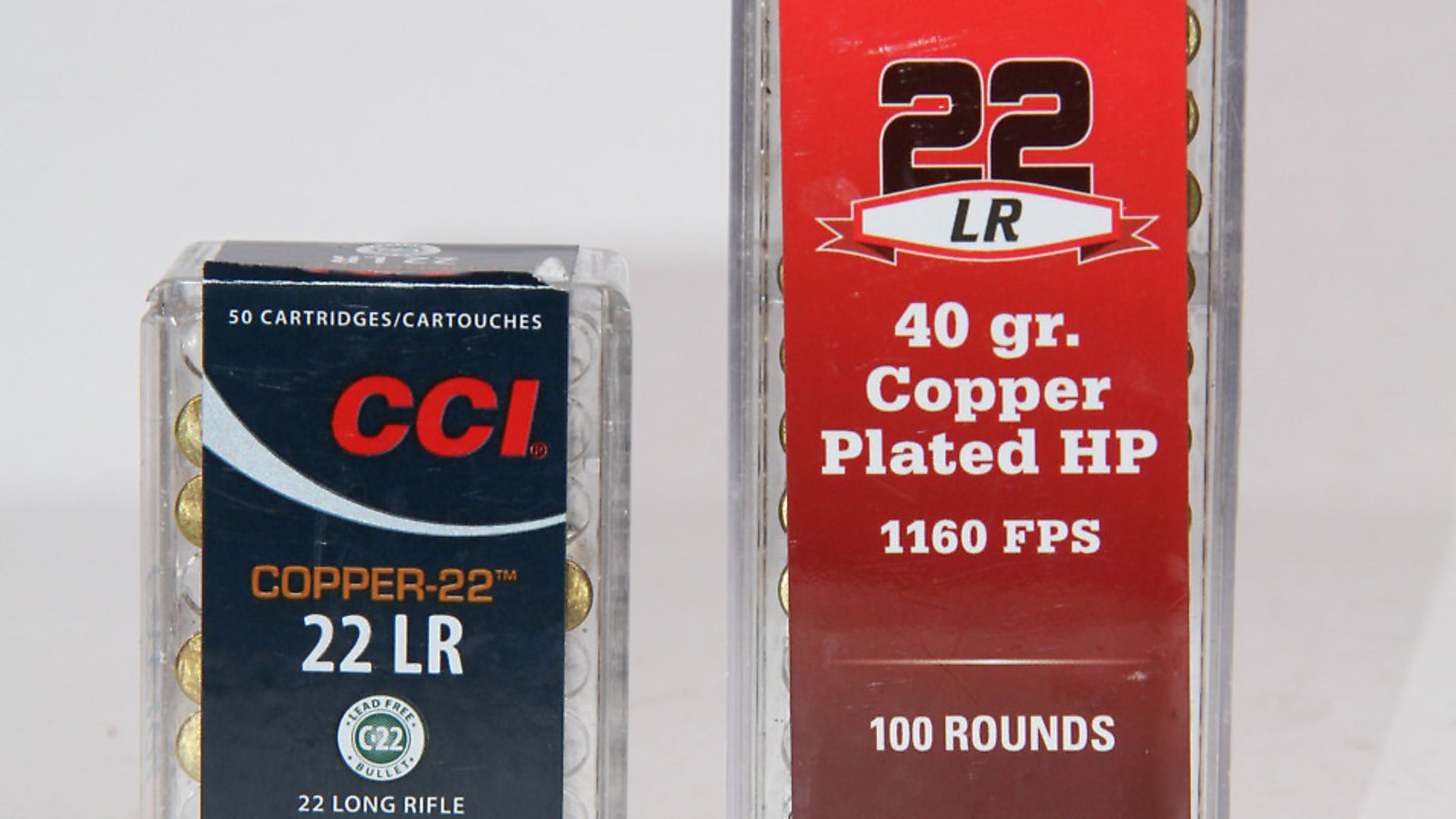 credit: Archant
credit: Archant
Options for lead-free bullets are ever increasing, as more manufacturers look for ways in which they can produce loads with less environmental impact.
Coating bullets is nothing new. High Velocity (HV) lead-core rimfire ammunition with a copper wash has long been considered advantageous in order to avoid barrel fouling at higher speeds. So, this month, we’re looking at both sides of the coin: CCI’s new copper .22 rimfire round that is entirely lead-free, and Hornady’s copper-plated lead bullet. Both are dubbed HV but have very differing velocities and bullet weights. The CCI utilises a 21gr bullet at speeds of 1850 fps while the Hornady Varmint Express loads uses the traditional 40gr bullet at a just HV 1150 fps.
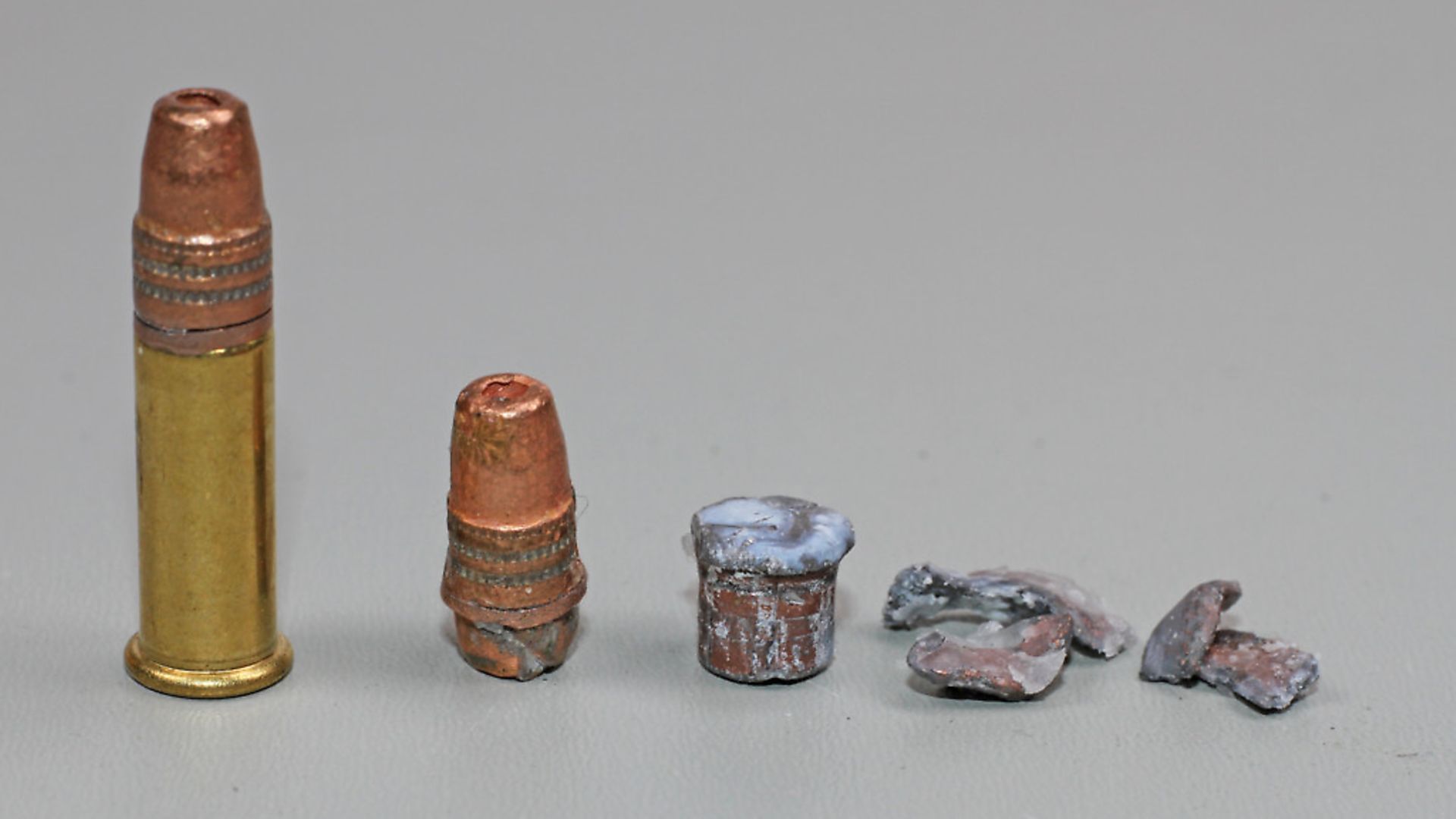 credit: Archant
credit: Archant
The specs
The CCI Copper-22 is an odd-looking round as it has a very conical, almost CB Long-type, bullet profile with a small hollow point. What makes it doubly striking is the muted bronze colour to it; the sides are quite straight and the smooth profile has a small raised driving band just as the bullet enters the case mouth.
The bullet is made of a copper/polymer mix, creating a unified bullet of 21gr that is light and claims speeds of over 1850 fps. Thus, a hyper velocity round, like the CCI Stinger that has a 32gr bullet travelling at 1640 fps. The whole round weighs 33.4gr and uses a standard Long Rifle brass casing with the rear portion of the bullet heavily crimped into place. The powder capacity is large at 2.6gr of black flake and nearly fills the case! Because the bullet is quite long for its weight (copper is lighter than lead), the overall length of the cartridge is 0.9455”, so it still feeds well through a magazine rifle.
Hornady’s Varmint Express Copper Plated HP is a nice comparison as it uses copper plating to shield the conventional lead core beneath. The bullet takes the conventional truncated cone look with a central driving band and two cannelure grooves hold the waxy lube (NB: there’s no lube on the CCI Copper-22).
There is a large hollow point design and the overall length of the round is 0.9715” – longer than the CCI due to the extra weight of the bullet at a measured average of 39.8gr.
Powder wise, you have the std 1gr of black flake and both rounds have a bullet diameter of 0.223”. Velocity is a mild 1160 fps (advertised speed) and 1191 fps when tested through my Sako Finnfire 14.5” barrel, so it’s quite a low velocity HV round to be honest.
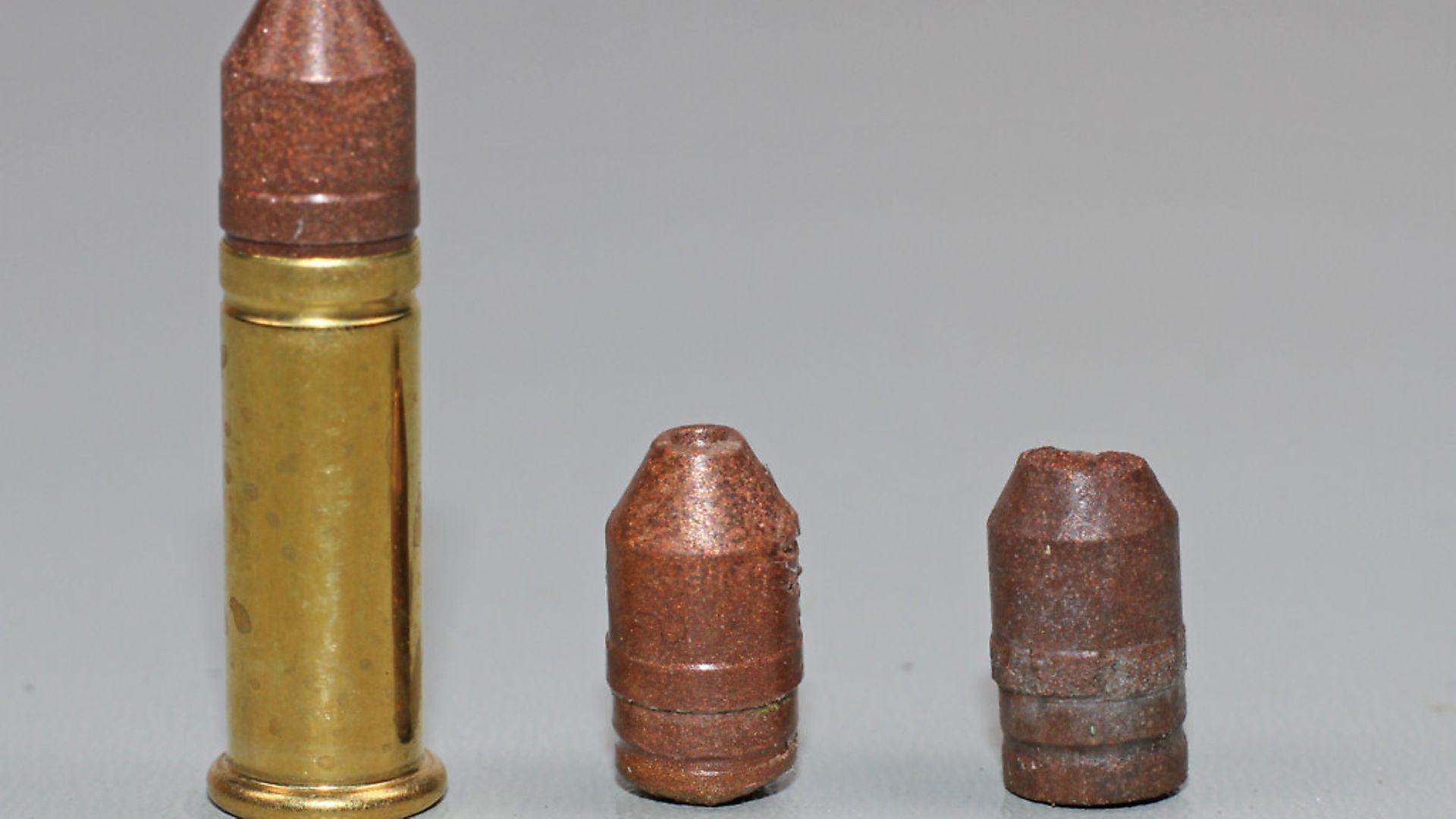 credit: Archant
credit: Archant
test analysis
I shot both the rounds in a Ruger 10/22 to see how well they fed. No issues at all with the Hornadys but the CCIs did have a few stack poles feeding from the magazine, as I guess the lighter bullet flipped up when stripped from the magazine. I did notice a larger bolt whiplash to when firing the CCIs.
Accuracy wise, the Hornady’s again fared better. The rifling was able to stabilise the bullet and it shot well: an average of 0.65” five-shot groups at 30 yards and 0.95” at 50 yards.
The CCI Copper-22 was a disappointment. Whether it was the lighter bullet, or more likely the smooth shiny bullet surface not engaging the rifling, accuracy was poor. I did test them in several rimfires to no avail, and the Sako Finnfire was the best with 1.15” 30-yard groups and 1.65” 50-yard groups. No fliers as such, just quite a wide concentric spread between shots.
Velocity wise, the Copper-22 bullets were indeed fast and loud, let her rip tatter chip! From the 14.5” barrel, I had 1842 fps for 157 ft/lbs energy. The trouble came when measured for velocity down range for the true Ballistic Coefficient; as expected, that lighter bullet really shed its velocity fast. From muzzle (10ft in front of the chrono), the velocity dropped from 1842 fps/157 ft/lbs to 989 fps/45ft/lbs at 100 yards – that’s nearly half its velocity lost in the first 100 yards. Whereas the heavier Hornady bullet achieved 1191 fps for 125 ft/lbs energy at the muzzle and 1004 fps/69 ft/lbs at 100 yards, only a loss of 187 fps velocity.
What really interested me was the terminal performance in the ballistic media. You would think that the lighter, faster CCI bullet would expand more and the heavier Hornady would penetrate more and expand less. In reality, it was completely the opposite! Firstly, that CCI copper/polymer mix is tough and cohesive and therefore trying to get them out of the cases to measure and section was a drama, often splitting in two at the case mouth junction – a penetration of 8.45” compared to the 7.25” penetration of the Hornady bullet.
It also kept together with no expansion; it still measured 0.223” diameter and weighed in at 20gr, whereas the Hornady expanded to 0.286” and exposed the lead core from the hollow point and retained 28.8gr of the main bullet. The shrapnel from the sides of the hollow point added another 10.2gr so 4gr in total – obviously some media embedded itself.
But what was interesting was that, despite the lack of expansion, the CCI Copper-22 did create a larger wound channel volume at 25.4mls compared to the Hornady’s 21.2mls, only because the channel expansion size was a linear 0.421” for almost the whole length along its travel, whereas the Hornady had a larger initial expansion channel, producing 0.517”, but then a pretty straight cut through the media, only fragmenting toward the end.
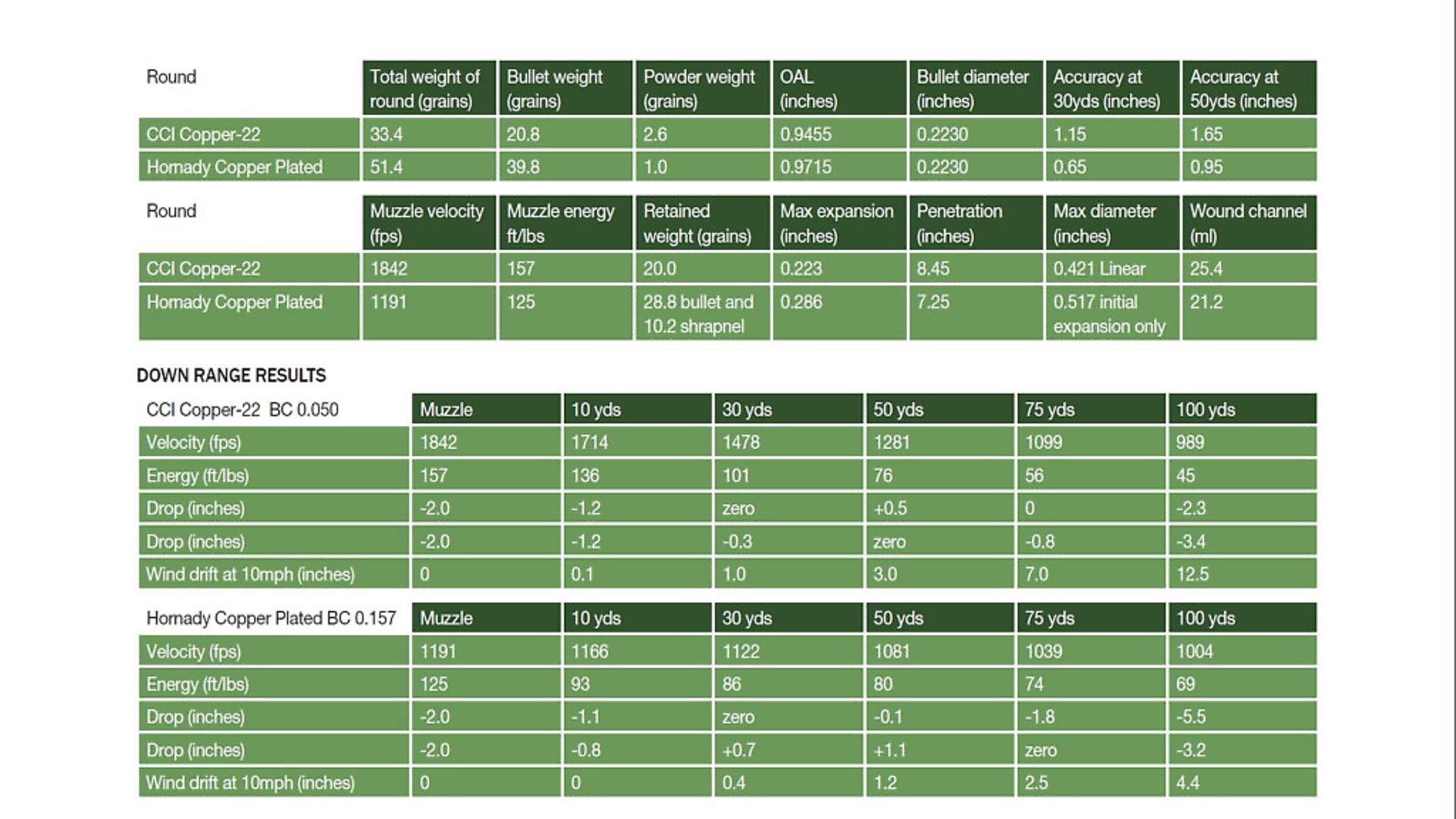 credit: Archant
credit: Archant
Down Range
The down range ballistics are very revealing in terms of how the BC difference between the two rounds effects the trajectory. The CCI Copper-22 dropped from an impressive 157 ft/lbs to 45 ft/lbs at 100 yards, whereas the Hornady’s heavier and slower 40gr bullet, starting at 125 ft/lbs, still had 69 ft/lbs at 100 yards. Momentum plays a big part in this. You can see when zeroed at 30 yards that the CCI Copper-22 is almost flat to 75 yards due to the velocity but drops to -2.3” at 100 yards range. Shifting the zero to 50 or 75 yards does not make a lot of difference.
Compare this to the Hornady round that when zeroed at 30 yards does drop more at 100 yards range to -5.5” and has a more looped trajectory. But re-zeroing to 75 yards gives the Hornady nearly the same drop as the CCI Copper-22 at 100 yards of -3.2”.
Even more striking is the wind drift difference: the Hornady only differs 0.4” at 30 yards and 4.4” at 100 yards, compared to the CCI’s 1” and a huge 12.5” at 100 yards.
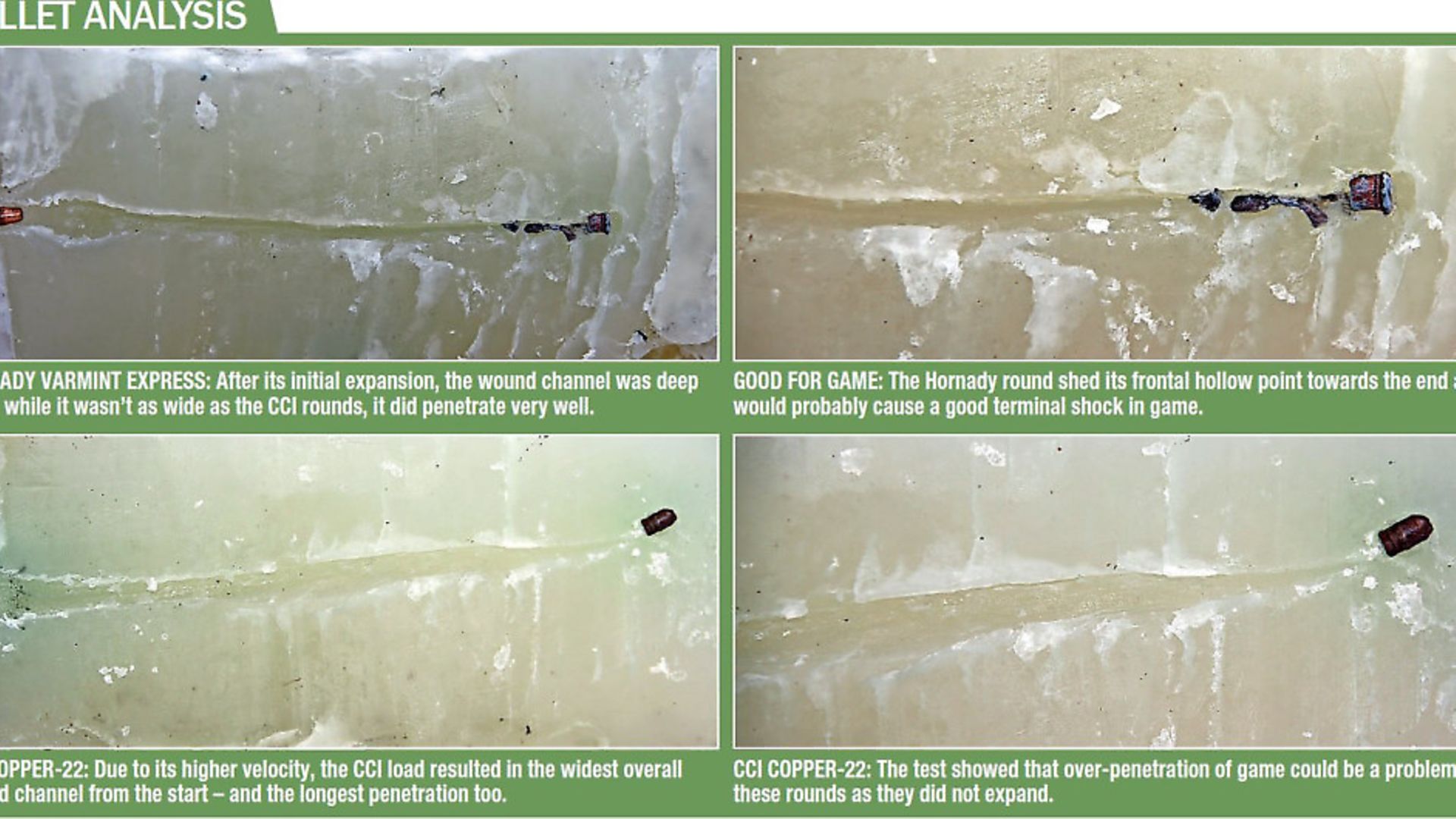 credit: Archant
credit: Archant
Conclusions
Ammo tests are always interesting, especially when you compare claimed performance and actual results! The CCI Copper-22 is totally lead free, which is good, but it is very hard and does not expand, so it’s limited for game use despite its high velocity. But even this is compromised by the average accuracy and dramatic drop in velocity due to the low BC value of this round. The Hornady, on the other hand, with its conventional lead bullet, copper plating and mild HV velocity, exhibited good accuracy at all ranges, good velocity and energy retention down range, and decent wound channel volume and penetration. The hunt for a nice lead-free expanding subsonic round continues!
CONTACTS
Product: Hornady Copper Plated
Price: £14.99 per 100
Supplier: Edgar Brothers:
Web: www.edgarbrothers.com
Tel: 01625 613177
Product: CCI Copper-22
Price: No RRP - see local retailers
Supplier: GMK Ltd
Web: www.gmk.co.uk
Tel: 01489 579999
Product: Chronographs
Supplier: Norman Clark Gunsmiths
Tel: 01788 579651